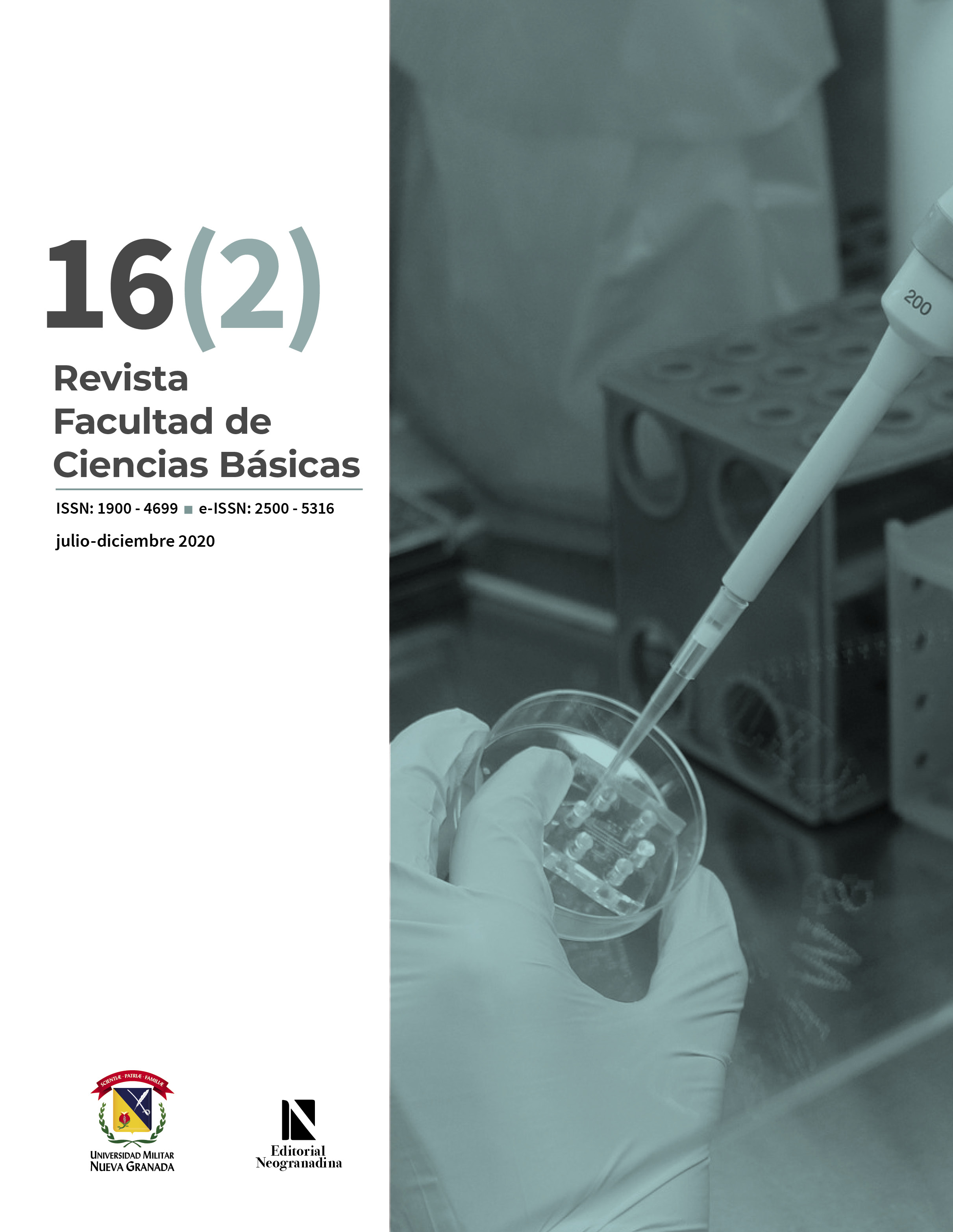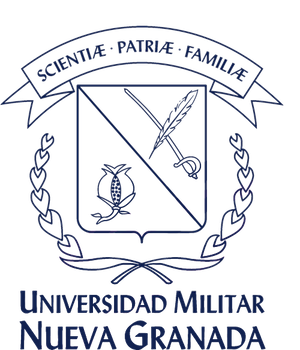Generación de las matrices de espín de Paulí a partir de los vectores de Jones
Resumen
Usando los estados de polarización de la luz representados por vectores de Jones que pertenecen a un espacio vectorial lineal complejo de una dimensión, se elaboran estructuras algebraicas que son conocidas como diadas o tensores de segundo orden que en este caso conforman un espacio vectorial complejo de dos dimensiones. Con estos tensores de segundo orden, que se pueden expresar de forma matricial, se construyen secuencias de relaciones de conmutación con alternancia de los estados de polarización de la luz. Las secuencias de relaciones de conmutación, con la propiedad de alternancia dada por la permutación de los estados de polarización de la luz, se presentan como combinaciones lineales que generan de forma simple las matrices de espín de Pauli. Los estados de polarización de los vectores de Jones utilizados para construir las secuencias de las relaciones de conmutación de las formas diádicas pertenecen a formas de tipo circular, a la izquierda y a la derecha, o lineal. La transición de un espacio vectorial complejo, en la que actúan los vectores de Jones, a un espacio vectorial lineal complejo de dos dimensiones, en el que la base de este último espacio lo conforman la matriz unidad y las matrices de espín de Pauli, es factible a través de relaciones de conmutación empleando vectores de Jones en estados de polarización lineal y circular.
Descargas
Referencias bibliográficas
L. J. Vandergriff, "Nature and Properties of Light", en Fundamentals of Photonics, Chandrasekhar Roychoudhuri. University of Connecticut, Photonics Lab, 1999, pp. 1-38.
V. V. Kotlyar, A. G. Nalimov y S. S. Stafeev, "Exploiting the circular polarization of light to obtain a spiral energy flow at the subwavelength focus", J. Opt. Soc. Am. B, vol. 36, n.° 10, pp. 2850-2855, 2019. https://doi.org/10.1364/JOSAB.36.002850
F. L. Pedrotti y L. S. Pedrotti, Introduction to Optics, 2a ed. Englewood Cliffs: Prentice-Hall, 1993.
C. Schrijver y C. Zwaan Solar and Stellar magnetic activity (Cambridge University Press, New York, 2000).
E. Bowel y B. Zellner in Proceedings of the International Astronomical Union edited by T. Gehrels (University of Arizona Press Tucson, 1974).
J.H. Oort y T Walraven Bulletin of the Astronomical Institutes of the Netherlands 12, 285 (1956).
R. Kulsrud y E. Zweibel, Reports on progress in physics 71, 046901 (2008).
A. Raftopoulos, N. Kalyfommatou y C. P. Constantinou, "The properties and the nature of light: The study of newton's work and the teaching of optics", Science and Education, vol. 14, n.° 7, pp. 649-673, 2005. [En línea]. https://doi.org/10.1007/s11191-004-5609-6
H. G. Jerrard, "Modern description of polarized ligth: matrix methods", Optics & Laser Technology, vol. 14, n.° 6, pp. 309-319, 1982. https//doi.org/10.1016/0030-3992(82)90034-2
J. Peatross y M. Ware, Physics of Light and Optics. Utah: Brigham Young University, 2008.
N. C. Pistoni, "Simplified approach to the Jones calculus in retracing optical circuits", Applied Optics, vol. 34, n.° 34, pp. 7870-7876, 1995. https://doi.org/10.1364/AO.34.007870
D. A. Steck, Classical and modern optics. University of Oregon: Oregon Center for Optics and Departament of Physics, 2006.
L. L. Frenzel, Sistemas Electrónicos de comunicaciones, 3ª ed. México, D. F: Alfaomega, 2003.
P. Gorroochurn, "The end of statistical independence: the story of Bose-Einstein Statistics", The Mathematical Intelligencer, vol. 40, n.° 3, pp. 12-17, 2018. https://doi.org/10.1007/s00283-017-9772-4
J. Arnaud, J. M. Boé, L. y F. Philippe, "Illustration of the fermidirac statistics", American Journal of Physics, vol. 67, n.° 3, pp. 215-221, 1999. https://doi.org/10.1119/1.19228
G. A. D. Briggs, J. N. Butterfield y A. Zeilinger, "The Oxford questions on the foundations of quantum physics", Proc R Soc A 469:20130299, 2013. https//doi.org/10.1098/rspa.2013.0299
R. Muller y H. Wiesner, "Teaching quantum mechanics on an introductory level", American Journal of Physics, vol. 70, n.° 3, pp. 200-209, 2002. https://doi.org/10.1119/1.1435346
A. I. Borisenko y I. E. Tarapov, Vector and tensor analysis with applications. Worth Publishers, 1979.
G. R. Hext, "The estimation of second-order tensors, with related tests and designs", Biometrika, vol. 50, n.° 3-4, pp. 353-373, 1963. https://doi.org/10.1093/biomet/50.3-4.353
J. O. Rodríguez, J. C. Rodríguez y A. C. Sevilla, "Un proceso de formalización matemática: Desde las rotaciones hasta las matrices de spin de Pauli", Lat. Am. J. Phys. Educ, vol. 2, n.° 3, pp. 323-330, 2008. [En línea]. Disponible en: http://www.lajpe.org/sep08/30_Orlando_Organista.pdf
E. Witten, "Quantum field theory and the Jones polynomial", en Braid Group, Knot Theory And Statistical Mechanics II, pp. 361-451, 1994. https://doi.org/10.1142/9789812798275_0013
S. M. Reyes, D. A. Nolan, L. Shi y R. R. Alfano, "Special classes of optical vector vortex beams are Majorana-like photons", Optics Communications, vol. 464, n.° 1, pp. 1-5(125425), 2020. https//doi.org/10.1016/j.optcom.2020.125425
F. R. G. Díaz y R. G. Salcedo, "El fenómeno del espín semientero, cuaternios, y matrices de Pauli", Rev. Matem.: Teor. y Ap., vol. 24, n.° 1, pp. 45-60, 2017. https://doi.org/10.15517/rmta.v24i1.27749
P. M. Morse y H. Feshbach, "§1.6: Diadas y otros operadores vector" Métodos de la Física Teórica, vol. 1, Nueva York: McGraw-Hill, 1953.
P. Mitiguy, "Vectors and dyadics", en Introductory matrix algebra, 2009, pp. 19-28.
G. F. Torres del Castillo, "Rotaciones y espinores", Rev. Mex. Fís., vol. 40, n.° 1, pp. 119-131. 1994. [En línea]. Disponible en: https://rmf.smf.mx/pdf/rmf/40/1/40_1_119.pdf
D. S. Durfee y J. L. Archibald, "Applying classical geometry intuition to quantum spin", Eur. J. Phys, vol. 37, pp. 1-9, 2016. https://doi.org/10.1088/0143-0807/37/5/055409
L. Desmarais, Applied electro-optics, New Jersey: Prentice Hall, 1998.
J. M. Marcela, "Polarización de la luz: conceptos básicos y aplicaciones en astrofísica", Rev. Bras. Ensino Fís., vol. 40, n.° 4, pp. e4310, 2018, doi: 10.1590/1806-9126-rbef-2018-0024
D. S. Kliger, J. W. Lewis y C. E. Randall, "Introduction to the Jones calculus, Mueller calculus, and Pincaré sphere", en Polarized Light in Optics and Spectroscopy, California: Academic Press, 1990.
G. F. Torres del Castillo e I. R. García, "The Jones vector as a spinor and its representation on the Poincare sphere", Rev. Mex. Fís., vol. 57, n.° 5, pp. 406-413, 2011. [En línea]. Disponible en: http://www.scielo.org.mx/pdf/rmf/v57n5/v57n5a4.pdf
E. V. Masalov, N. N. Krivin y S. Y. Eshchenko, "Analysis of the influence of a uniform hydrometeorological formation on the polarización characteristics of an electromagnetic wave", Russian Physics Journal, vol. 60, n.° 9, pp. 1469-1475, 2018.
T. Nishiyama, "General plane or spherical electromagnetic waves with electric and magnetic fields parallel to each other", Wave Motion, vol. 54, pp. 58-65, 2015. https://doi.org/10.1016/j.wavemoti.2014.11.011
R. Hubrich y M. Eckhardt, "Motion vector estimation employing line and column vectors", U. S. Patent 7,852,937 B2, dic. 14, 2010. [En línea]. Disponible en: https://patentimages.storage.googleapis.com/5f/c2/24/f4203476b78bf1/US7852937.pdf
R. C. Jones, "A new calculus for the treatment of optical systems. I. Description and Discussion of the Calculus", Journal of the Optical Society of America, vol. 31, n.° 7, pp. 488-493, 1941. https://doi.org/10.1364/JOSA.31.000488
R. C. Jones, "A New calculus for the treatment of optical systems. III. The Sohncke theory of optical activity", Journal of the Optical Society of America, vol. 31, n.° 7, pp. 500-503, 1941. https://doi.org/10.1364/JOSA.31.000500
E. Bretislav y D. Herschbach, "Stern and Gerlach: how a bad cigar heped reorient atomic physics", Phy. Tod., vol. 56, n.° 12, pp. 53-59, 2003. https://doi.org/10.1063/1.1650229
M. Danos, "Fully consistent phase conventions in angular momentum theory", Nucl., Part. Many Body Phy., pp. 319-334, 1972.
Y. Mohammed y A. Emadaldeen, "Separation of angular momentum", Am. J. App. Mat.s, vol. 4, n.° 1, pp.
-52, 2016. https://doi.org/10.11648/j.ajam.20160401.14
A. Bertapelle y A. Candilera, "Eigenvectors and eigenvalues: a new formula?", Boll Un. Mat. Ital vol. 13, pp. 329-333, 2020. https://doi.org/10.1007/s40574-020-00222-z
D. J. Griffiths, Intr. Quantum Mechs. Nueva Jersey: Prentice-Hall, 1995.
I. M. Greca y O. Freire, "Teaching introductory quantum physics and chemistry: caveats from the history of science and science teaching to the training of modern chemists", Chem. Educ. Res. Pract, vol. 15, pp. 286-296, 2014. https://doi.org/10.1039/C4RP00006D
J. Kronsbein, "Kinematics-Quaternions-Spinors-and Pauli's Spin Matrices", Am. J. Ph., vol. 35, pp. 335-342, 1967. https://doi.org/10.1119/1.1974074
D. A. Konkowski, T. M. Helliwell y C. Wieland, "Quantum singularity of Levi-Civita spacetimes", Class. Quantum Grav., vol. 21, n.° 1, pp. 265-272, 2004. https://doi.org/10.1088/0264-9381/21/1/018
G. B. Arfken y H. J. Weber, Física Matemática: Métodos Matemáticos para Engenharia e Física, 6a ed. Río de Janeiro: El Sevier, 2007.
H. U. Haq, "Geometry of spin: clifford algebraic approach", Resonance., vol. 21, pp. 1105-1117, 2016. https://doi.org/10.1007/s12045-016-0422-5
L. Boi, "Clifford geometric algebras, spin manifolds, and group actions in mathematics and physics", Adv. Appl. Clifford alg., vol. 19, pp. 611-656, 2009. https://doi.org/10.1007/s00006-009-0199-7
H. Goldstein, C. P. Poole y J. L. Safko, Classical mechanics, 6a ed. Addison-Wesley, 2001.
D. L. Schwartz, "The emergence of abstract representations in dyad problem solving", J. the Lear. Sc., vol.4, n.° 3, pp. 321-354, 1995. https://doi.org/10.1207/s15327809jls0403_3
R. C. Jones, "A new calculus for the treatment of optical systems v. a more general formulation, and description of another calculus", J. Op. Soc. Am., vol.. 37, n.° 2, pp. 107-110, 1947. https://doi.org/10.1364/JOSA.37.000107
P. Yeh, "Extended Jones matrix method", J. Soc. Am., vol.. 72, n.° 4, pp. 507-513, 1982. https//doi.org/10.1364/JOSA.72.000507
A. V. Volyar, T. A. Fadeeva y V. G Shvedov, "Optical vortex generation and jones vector formalims", Op. Spec.,vol. 93, n.° 2, pp. 267-272, 2002. https://doi.org/10.1134/1.1503758
A. Lien, "A detailed derivation of extended Jones matrix representation for twisted nematic liquid crystal displays", Liq. Crys., vol. 22, n.° 2, pp. 171-175, 1997. https://doi.org/10.1080/026782997209531
S. R. Cloude, "Group theory and polarisation algebra", Optik, vol. 75, n.° 1, pp. 26-36, 1986. [En línea]. Disponible en: http://pascal-francis.inist.fr/vibad/index.php?action=getRecordDetail&idt=8138457












